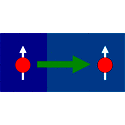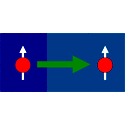Spin injection with half-metals: A perfect match
The efficient injection of a spin-polarized current from a magnetic material into a semiconductor is one of the important prerequisites for spintronics. With dilute magnetic semiconductors, or traditional ferromagnets such as Ni, Fe, Co, and their alloys, it is possible to achieve fairly high spin injection efficiencies. However, often the spin polarization is weak or the interfaces are difficult to engineer and control.
In a Rapid Communication appearing in Physical Review B, Manfred Ramsteiner and collaborators from the Paul-Drude-Institut in Berlin discuss an important development in spin injection using another class of materials, called Heusler alloys, some of which have long been predicted to be half-metals [1]. Half-metals, which are extremely rare in nature, have 100% spin polarization at the Fermi level, and therefore only pass a current in which the electrons are polarized either “up” or “down.”
Up to now, attempts to use Heusler alloys as spin injectors have not been promising because the alloy becomes disordered at the interface with the semiconductor and the spin polarization is greatly reduced. By better understanding the alloy-semiconductor interface, Ramsteiner et al. have reached a spin injection efficiency of at least 50% from into GaAs. This is the highest efficiency achieved so far with a Heusler alloy.
is unusual in many respects—there are indications that it indeed might be half-metallic, it remains ferromagnetic up to 1100 K and has the largest magnetic moment among the Heusler compounds. Most importantly, it has a crystal structure that matches perfectly with that of III-V semiconductors, which allows for fabrication of high-quality interfaces. – Ashot Melikyan
[1] de Groot et al., Phys. Rev. Lett. 50, 2024 (1983).





